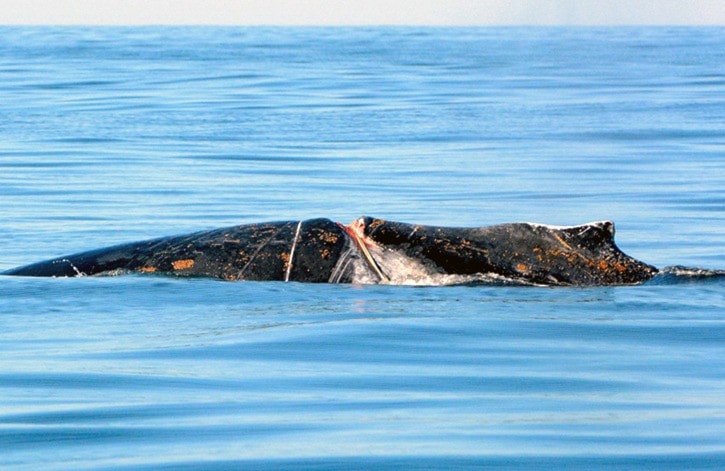A brand new satellite tagging system was used to rescue an entangled young humpback whale near Ucluelet on Sunday.
The whale was ensnared in what’s believed to be crab gear and dragging three buoys, according to Department of Fisheries and Oceans Canada (DFO) marine mammal coordinator Paul Cottrell.
“It’s a young animal and it was labouring obviously with all the gear, ropes and floats on it,” Cottrell told the Westerly.
“We worked on it for a couple of hours and were able to get up close enough and make the cuts and remove the gear so it was just brilliant.”
He said the ropes had dug into the animal’s tail and a roughly 12-centimetre depression had healed over, leaving necrotized tissue.
“These buoys, we estimate, were on the animal for a multiple number of months. They had worn into the blubber quite a bit and the tail fluke had some damage,” he said.
“Often with these entanglements, there are definite injuries and scars. But, it’s good that we can get in and get it off because it almost certainly would have died if we hadn’t,” Cottrell said.
He expects the young humpback to make a full recovery.
“We’re optimistic,” he said. “They’re extremely resilient animals.”
He said the entanglements would have caused the humpback a considerable amount of pain.
“This suffering is human caused,” he said. “They can die a slow inhumane death and it’s just awful.”
The gear the animal was trailing has not yet been identified but an investigation is ongoing.
“We haven’t been able to work it back to Canadian gear yet…It might be from a different country, so we’re working on that right now but we’re pretty sure it’s crab gear,” Cottrell said.
“We want to work back and find out exactly where it got caught up and how…just to see if there are things we need to change.”
The distressed humpback had been spotted several times in the week leading up to its rescue, including sightings from Coast Guard and Department of National Defence helicopters in the area, and Cottrell said DFO spent a day looking for the animal to no avail.
He said a Jamie’s Whaling Station vessel spotted the whale near Crow Island on Sunday, reported it and kept their eyes on it until DFO and Parks staff arrived and got their first crack at using a new satellite buoy tracking system.
The crew had only received the satellite, and been trained on how to use it, the week prior.
“The fact that the training was last week was so fortuitous,” Cottrell said adding local training sessions will continue.
The local response team used a grappling hook to attach the satellite onto the ropes the whale was trailing and Cottrell said this new system would be invaluable for future rescue efforts.
“If it’s a disentanglement candidate, we’ll get them to put the satellite tag on and then I can mobilize all my equipment and the team and get up there,” he said.
“Were hoping to increase our success rate. So far it’s showing huge promise and that’s going to be great for the program and hopefully great for the whales.”
He said local responders would be able to attach the satellite to an entangled whale and buy time for his DFO disentanglement team to assemble without the usual fear of losing sight of the animal.
“With the satellite tag, we can actually track it through a laptop and then get out there and get the job done. And, we can start earlier in the day because some of these animals take a lot longer to tire out to be able to get close enough and cut the gear,” he said.
“It’s going to make a big difference…If we can locate the animal and get out there, our success rate is huge.”
He said the satellites have been dished out to coastal communities where whale entanglement rescues are the most common, including Tofino-Ucluelet.
“These tags are $5,000. They’re really expensive so we only have a limited number and we’re putting them in strategic places,” he said adding Port Hardy and Haida Gwaii have also received satellites.
While the satellite system is new, Cottrell touted Jamie’s Whaling Station’s assistance as an old reliable that proved vital to Sunday’s rescue.
“They’ve been fantastic,” he said.
“They call us right away and they make that extra effort to stay in the water and keep the eye. They do exactly the right thing. They don’t interact with the whale or the gear because that’s a no-no. They keep their eye on the whale and then we can get out there and do our thing.”
